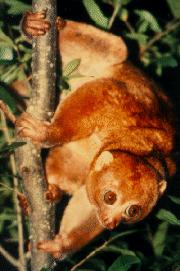Lorises and pottos are small (85 g - 1.5 kg), arboreal primates of Africa and Asia. Six species placed in 4 genera make up the family (which is also known as the Lorisidae). They are small animals, stealthily stalking insects or seeking fruit at night and spending the day in hollow trees or clinging to branches. Lorids climb with deliberate, hand-over-hand movements, never leaping between branches. While their actions are usually slow and deliberate, they are capable of moving rapidly if necessary. The hands and feet of lorids are capable of powerful grasping, and these animals travel along the underside of branches as easily as along the top. Their tails are very short, seemingly absent in some species.
Loridae
lorises, slow lorises, pottos, angwantibos
Lorids have thick, wooly pelage, darker on the back than the venter. Their eyes are large and directed forward.
Lorids are probably closely related to the the Galagonidae, and sometimes that family is considered to be a subfamily within the Loridae. Here, we follow current practise and record them as separate.
Lorids have strongly constructed skulls with well-defined temporal ridges. The braincase is rounded and the anterior (rostral) parts of the skull reduced. Their orbits are directed forward. Postorbital processes are present and wide, and the zygomatic arches are broad. The bullae are only moderately inflated, and the external auditory meatus is continuous with the zygomatic branch of the squamosal. The palate ends behind the last molar.
The teeth of lorids are diverse and variously specialized. As in other strepsirrhines, the lower incisors and canines form a comb-like structure. The most anterior lower premolars are canine-like. Upper canines are long and well-developed, and the molars have three or four cusps. The dental formula is 2/2, 1/1, 3/3, 3/3 = 36.
The postcranial anatomy of lorids is also rather highly specialized. Their wrists appear modified for "armswinging" locomotion, similar to hominoids. Fore and hind limbs are approximately equal in length. On the feet, the hallux and pollex are well developed and strongly opposed to the remaining digits, more so than in the related galagos. All digits have nails except the second of the hind foot, which has a typical strepsirrhine "toilet claw." The arterial and venous circulation of the arms and legs is much subdivided to form networks of intertwining vessels (retia mirabilia), which facilitate the exchange of oxygen and waste materials and help the muscles remain contracted over long periods. The fossil record of the lorids extends back to the Early Miocene.
HOME
Primates
Primate FAQ
Loris Pictures
Potto Pictures
Primate Species
Angwantibo Pictures
Search Primates.com
Primates E-Mail Service
